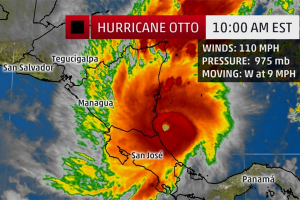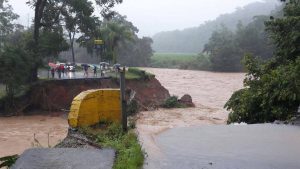As I write this recovery efforts are underway to clean up the mess left in the wake of Tropical Storm Nate. Nate formed in the southern Caribbean sea. That’s a bit strange, since the majority of these tropical systems form off of the western African coast, or in the Gulf of Mexico. Nate produced as much rain in the matter of a couple days as Costa Rica normally experiences in the entire month of October, which incidentally already is one of Costa Rica’s rainiest months.
The results were devastating to many communities, especially low lying ones. The wind was not the issue, nor storm surge, but the rain. The inordinate amount of rain that fell in the mountains and rapidly made its way down the steep slopes to the coast caused catastrophic flooding, landslides, and washed away key bridges. Seven people were killed by the storm and there are some 15 more currently missing.
That might be changing.
Perhaps we’ve forgotten, but last year there was Hurricane Otto. Otto also formed in the southern Caribbean sea. It hit Costa Rica in November of 2016, resulted in massive amounts of rainfall, which caused flooding, landslides, and washed away key bridges. That stormed claimed the lives of ten in Costa Rica and more in other Central American countries.
I’m no scientist. I did grow up on the Carolina coast and do have quite a bit of experience with these types of storms. And I do know that scientists have been telling us for some time that climate change will increase the frequency and ferocity of these storms.
Do storms in two consecutive years equal a trend for Costa Rica? I don’t know, but it is alarming.
It’s also a problem for all those expats who tend to invest in coastal areas.
For the sake of full disclosure, I am a Coldwell Banker real estate agent out of the Dominical office. I do sell beach properties to expats, along with the other 140 or so agents along the Costa Ballena. However, I am also one of the few who’s focused on selling mountain properties. I live in the mountains in Perez Zeledon. I’ve written before about the Costa Rica mountains versus beaches dilemma…you can read those posts here and here.
However, common sense is beginning to lead to the conclusion that beach properties, especially in low lying areas that are prone to flooding, might not be the wisest choice.
Right now the Costa Ballena area is suffering greatly from the effects of this storm. Bridges are out to the north, south, and eastern access points, virtually isolating the area from the rest of the country. Supplies coming down from San Isidro de El General have virtually stopped until key infrastructure improvements can be made. That will take some time. Many coastal residents have lost everything in the flooding that resulted from Nate’s massive amounts of rainfall.
Up here in San Isidro we fared a bit better. Our many beautiful rivers and creeks did rise to alarming heights, but all that water was fast on its way somewhere…it didn’t hang around. And that somewhere was the coast.
San Isidro is a large enough town that we are doing OK, so far, with supplies. Much of that has to be delivered from San Jose and the roads are closed for the time being, but clearing is well underway.
My “MO” has been to expose wanna-be expats to both mountains and beaches. They both are wonderful areas to live in, especially here in our gorgeous southern zone. However, if these two annually consecutive storms do indicate a trend, I believe this might provide another factor to consider when contemplating the Costa Rica mountains versus beaches decision.
And remember, the mountains in the southern zone are less than an hour from the beach!
If you’d like to help the victims in Costa Rica from the devastation of Tropical Storm Nate, you can do that here…
https://amigosofcostarica.org/product/help-victims-tropical-storm-nate/


I enjoy reading your articles, they are always informative. I will traveling to the southern coast in January and am planning a driving trip from Ojochal to San Gerardo de Dota. Did the roads in that region survive the storm? Thanks